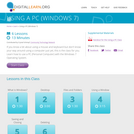
Learn how to use a PC with the Windows 7 Operating System.
- Subject:
- Education
- Material Type:
- Lecture
- Provider:
- Institute of Museum and Library Services
- Provider Set:
- DigitalLearn.org
- Date Added:
- 07/19/2013


Learn how to use a PC with the Windows 7 Operating System.

ESL lesson plan for use in orientation to videconferencing platforms such as Zoom and Google Meet. Students practice using microphone mute/unmute and the chatbox to report about the poeple in their homes and read about their classmates' homes using the present progressive tense.
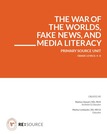
The following unit offers multiple entry points into developing an understanding of media literacy. The unit framework and primary sources can be integrated into classrooms of grades 4-12. Each lesson has student objectives that can be accomplished within 40 minute periods over the course of several weeks. A midpoint writing assessment, whole class capstone debate, and final independentwriting assessment are included. Support materials are integrated into the lessons, and the primary source document pages can be found at the end of the unit guide.
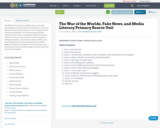
The following unit offers multiple entry points into developing an understanding of media literacy. The unit framework and primary sources can be integrated into classrooms of grades 4-12. Each lesson has student objectives that can be accomplished within 40 minute periods over the course of several weeks. A midpoint writing assessment, whole class capstone debate, and final independent writing assessment are included. Support materials are integrated into the lessons, and the primary source document pages can be found at the end of the unit guide.
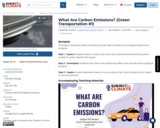
SYNOPSIS: This lesson introduces carbon emissions and the idea of carbon and ecological footprints to students.
SCIENTIST NOTES: Students understand key greenhouse gases that cause global warming, explain the greenhouse effect, identify carbon sources from the various transportation modes, and explore ways to reduce their individual carbon footprint from the transportation sector. All materials are well-sourced. As a result, this lesson has passed the science credibility process and is recommended for teaching.
POSITIVES:
-This lesson connects to science standards and the understanding of the relationship between human activities and Earth.
-Students will develop a strong connection to self and the environment.
-This lesson features interaction with technology and digital literacy.
-This lesson features excellent vocabulary development.
ADDITIONAL PREREQUISITES:
-This is lesson 1 of 6 in our 3rd-5th grade Green Transportation unit.
-If students do not have a prior understanding of photosynthesis, it may be best to do a mini lesson on photosynthesis.
DIFFERENTIATION:
-Definitions can be broken down for friendlier understanding.
-You can pause the videos to check for understanding and explain new ideas.
-Questions on the ecological footprint calculator quiz can be read aloud to students and taken as a whole class.
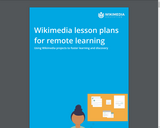
As part of our COVID-19 response efforts, the Education team at the Wikimedia Foundation has developed a series of lesson plans and challenge prompts that help educators incorporate Wikipedia and its sister projects in remote learning environments. Wikipedia is the largest free online encyclopedia and it’s in the top 10 most visited websites in the world. These educational proposals offer dynamic and engaging ways for teachers and guardians to complement remote education strategies, help students develop digital literacy skills, and engage in some of the largest collaborative free knowledge projects.
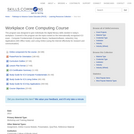
This program was designed to give individuals the digital literacy skills needed in today's workplace. Covered in this program are the topics tested on the internationally recognized IC3 exam - Computer Fundamentals (Computer Basics, hardware/software, networks); Key Applications (MS Office Suite); and Living Online (using the Internet effectively for research and communication).
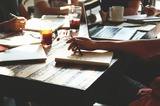
Overview: In this lessopn students will use Google Docs, Search and Drive to research, organize, write, and defend a point of view essay. Content/Context: The content area for this is writing for History/Social Studies, Science, and Technical Subjects. In addition several key digital literacy skills will be put into practice. Length of lesson: Multiple lesson sessions up to a couple of weeksNorthstar Digital Literacy Standards: Locate potentially relevant information in media found online, including text, video, images, etc. Locate the source of the information.File/store information in a format that facilitates ease of access for future use (e.g., file naming, folder organization, bookmarking, etc.)Synthesize relevant information from one or more sources.Integrate new information into current knowledge and use it to support understanding, views, perspectives, or opinions.CCRS Standards addressed:W.9-10.1WHST. 9-10.1Lesson Objective(s): At the end of this lesson, students will be able to:Search For and bookmark relevant and reliable sources for a persuasive essay.Be able to navigate in Google Search and save links and information to a Google DocFormat and write an essay in Google DocSave to a Google Drive folderAssessing Mastery of the Objective(s): By the end of this lesson, students will be able to access information, format and write an essay, with sources cited and make the essay available in a shared Google Drive folder Materials/links:computersPen and PaperOutline:Introduction:Explain that students will be writing a persuasive essay of their choice of topic using sources cite from the internet.. Explanation/Modeling:Demonstrate on a computer (projected if needed) the workflowIdentify topicSearch for sources; assess reliability and relevanceSave citations and relevant quotes or notes in a Google DocFormat and write essay in Google DocSave essay to a Google folderGuided Practice:Start by asking for topic ideas. Have students pair up, with each taking an opposing view point. When students have a topic, have them each list 4 or 5 points in support of their idea and organize them in a logical order. Discuss how to identify and assess the reliability and relevance of information found on the WebAllow time for searching sources, aiding the students in refining their search terms to find information supporting their claim and refuting it. Use pen and paper to take notes and refine essay plan.Have students open their Google Doc and begin formatting and writing a 5 paragraph essay in support of their idea. Make sure they use the points against to acknowledge some potential weaknesses in their argument.Walk students through the process of creating and sharing a Folder with their partner and the teacher. Partners are then encouraged to read and comment on their opponents essay. Students should continue to refine their essay in response to comments.At end of lesson, have students share folders with all students and vote on which ones are most persuasive.
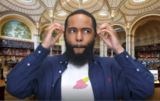
We all know how easy it is to spend hours watching videos on YouTube. Why do we go down that rabbit hole? Mostly because of a combination of computer programming and marketing know-how called ALGORITHMS.
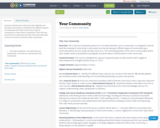
Learners will intereact with each other digitally and through conversation to talk about the different aspects of community be it their locale, their cultural community or their ethnic community. They will read an article on community and will come away with ideas on how to be more involved in their community.

All things in moderation. This phrase is typically heard in reference to a person’s diet or exercise habits. Given the tremendous rise in social media use among adolescents, moderation is something that can also be practiced in our relationships with the digital world. My theater students' social lives occur predominately online through various social media like SnapChat or Instagram. The relentless comparisons they make between themselves and their peers is correlated to a feeling of unworthiness. In my classroom, I often hear my students say, “I am not good enough” or “I am not as pretty or talented as...” Theatre is an art that should help students find the power of their own voices. However, this can only happen if a student is open to the exploration of the self. What if an oversaturation of social media is blocking my students from digging into their identities because they feel as if their “self” could never possibly be good enough? This unit seeks to guide my students on a journey of self-exploration in order to create a healthier relationship with social media. Ultimately, I want my students to feel worthy enough to participate fully in the art of theatre. For this to happen, my students need to break down the emotional blocks built by social comparisons that happen through social media.

The project partnership involves five schools from Finland, Hungary, Italy, Slovenia and the coordinating school from Spain and we aim to prepare students for a society dominated by technology and equip them with competences and knowledge built on digital literacy and foreign language skills which can give them the opportunity to implement mobility both within European education and labour market. We want this project to teach our students to become European citizens actively involved in a digitalized society and we are convinced that by providing our students with better digital skills, they will have better job opportunities in the European market as well as a sense of responsibility in terms of technology use.
We also aim to promote education for volunteering as a component of European active behaviour since students will learn how to better work in teams, develop leadership and problem-solving skills, and do volunteer work. This is not only essential for schoolwork but also for further involvement in the community. Therefore, throughout the project there will be practical volunteering activities performed by students, parents and teachers of all partner schools at local and international level.
We also have a concern for disadvantaged students and underachievement, so as teachers we have a need to improve our teaching skills to develop innovative approaches and practices that contribute to the implementation of inclusive methodologies and also to a greater achievement of our students’ basic skills. We want to enhance our digital skills in order to motivate our students and address diversity with the use of innovative ICT tools.
To achieve our aims all schools have agreed on the following objectives:
- Develop and enhance digital literacy, skills and inclusion.
- Make students aware of the need to make a safe use of new technologies and promote a responsible and respectful digital behaviour.
- Increase the European civic competences and behaviour through volunteering.
- Cooperate and exchange good practices and innovative methods to motivate and engage students with the help of ICT tools
- Enhance language skills in first and second languages as well as intercultural competences to improve the student’s command in ICT and skills for work.
- Promote digital training for students and teachers in the use of open educational resources (OER).
The activities have been planned in a way that the project covers the nine elements of Digital Citizenship, namely Digital Access , Digital Commerce, Digital Communication, Digital Literacy, Digital Etiquette, Digital Law, Digital Rights and Responsibilities, Digital Health and Wellness and Digital Security.
Our project includes activities involving participating and working together on tasks at national level and others with students from the five schools of the partnership collaborating and working jointly during mobilities. They will mainly be implemented in the form of non-formal learning, using tools that are the most suitable for assessing the acquired knowledge and skills.
As regards the beneficiaries of the project, the target groups will go through a transparent selection process to take part in the mobilities, but project activities will also involve teachers, students’ families, volunteer students, outside partners, foundations, local authorities and communities for a better impact and dissemination.
We expect tangible and intangible results. Students will have an online portfolio where they collect all the materials created – at the end of the project, based on their work and a test, a digital driver’s licence will be awarded – it will later be used for other students as well and incorporated in the curriculum. Students will take part in debate sessions on topics related to project work during student exchanges.
· Teachers will learn new ways to motivate students with mobile and ICT tools. They will create a manual of their teaching practice on digital citizenship and tools for different educational purposes in different subjects.
The project will have an impact on the students’ future development as the skills acquired will contribute to the improvement of their academic achievements and entering the world of work.
The European dimension will be reinforced as a result of the sustainable cooperation of the five partner schools. Mobilities, methodological changes, and the internationalization of the institutions will mark a turning point at school level after the European experience and will serve as the basis for future cooperation. The project will also help create long-lasting synergies with institutions and collaborating partners in the activities at local, regional and international level. We will seek opportunities for carrying on joint activities based on our project findings and will take part in a new eTwinning or another international project trying to involve as many new members as possible